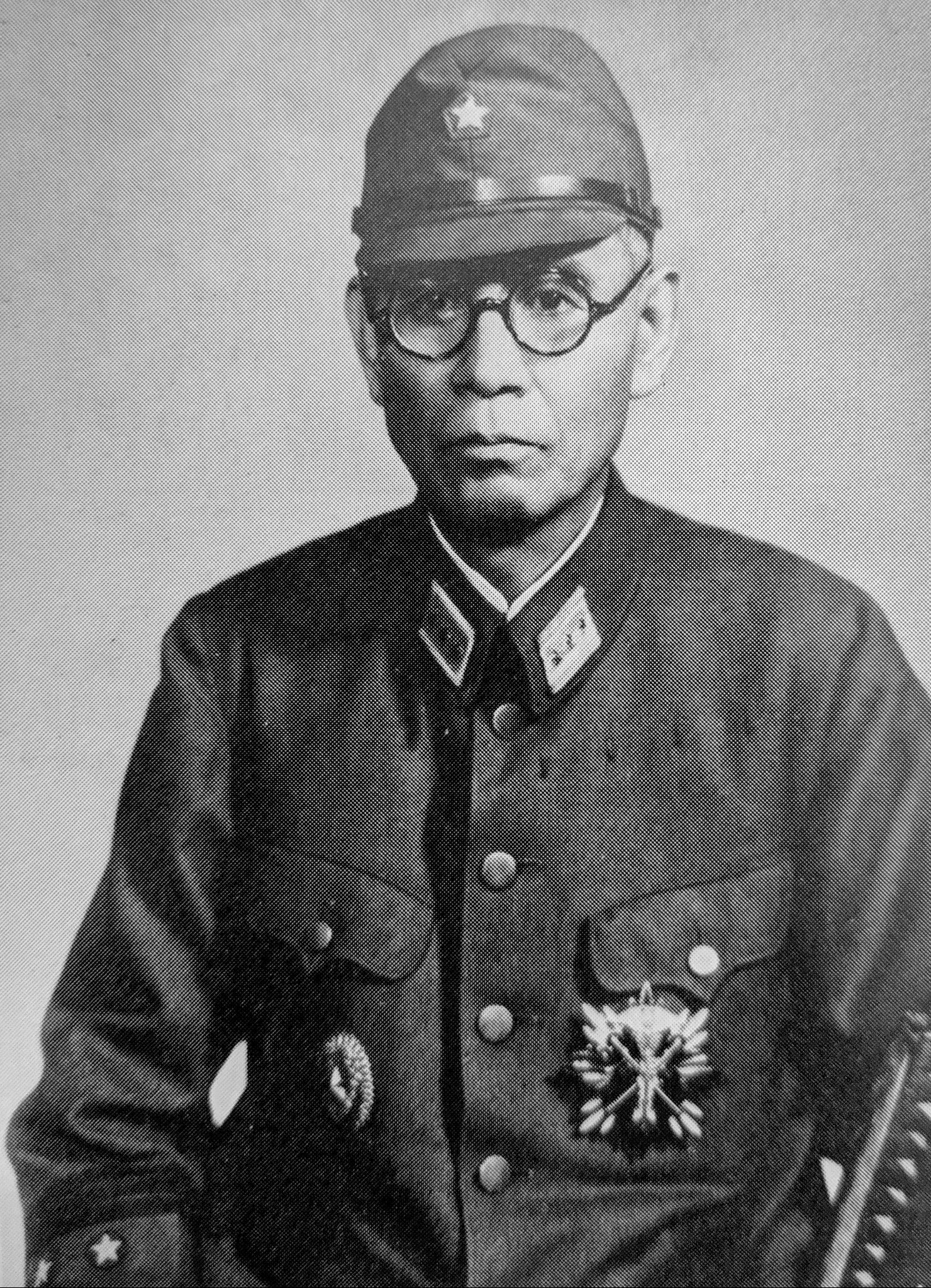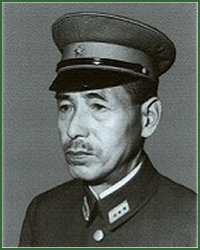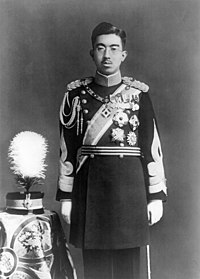ทหารกองจักรวรรดิญี่ปุ่น
| Imperial Japanese Army (IJA) 大日本帝國陸軍 Dai-Nippon Teikoku Rikugun ไดนิปปง เทโกกุ ริกุคัง | |
|---|---|
 | |
| ช่วงเวลาที่ทำหน้าที่ | 1867 – 1945 |
| ประเทศ | |
| กำลังทหาร | ~1,500,000 คน |
| Engagements | สงคราม ชิโน-ญี่ปุน สงครามรัสโซ-ญี่ปุ่น สงครามโลกครั้งที่๑ |
| Commanders | |
|---|---|
นายทหารระดับสูง | |

Yamagata Aritomo(14 มิถุนายน 1838–1 กุมภาพันธ์ 1922)

Ōyama Iwao (10 ตุลาคม 1842 - 10 ธันวาคม 1916)

Kotohito Kan'in (10 พฤศจิกายน 1865 – 21 พฤษภาคม 1945),

Hajime Sugiyama

Hideki Tojo (30ธันวาคม 1884 – 23 ธันวาคม 1948)

Yasuji Okamura(15 พฤษภาคม 1884 - 2 กันยายน 1966)

Shunroku Hata(26 กรกฎาคม 1879 - 10 พฤษภาคม 1962)

Tadamichi Kuribayashi (7 กรกฎาคม 1891-23 มีนาคม 1945)

Tomoyuki Yamashita(8 พฤศจิกายน 1885 - 23 กุมภาพันธุ์ 1946)

Masaharu Homma (27 พฤศจิกายน 1887 – 3 เมษายน 1946)
ทหารกองจักรวรรดิ หรือ Imperial Japanese Army (IJA) (Kyūjitai: 大日本帝國陸軍, Shinjitai: 大日本帝国陸軍, สะกดว่า: Dai-Nippon Teikoku Rikugun), หรืิอจะเรียกว่า กองกำลังญี่ปุ่นเพื่อความยิ่งใหญ่ เป็นชื่อที่ใช้อย่างต่อเนื่องจนกระทั่งปี 1867 ถึงปี 1945. ซึ่งควบคุมโดยนายพลแห่งกองจักรวรรดิ และนักการเมืองหัวรุนแรง, ซึ่งทำอย่างเพื่อจักรพรรดิ และให้จักรพรรดิเป็นผู้ทรงพระบัญชาแต่เพียงผู้เดียวทั้งสองเหล่าทัพ กองทัพบกและกองทัพเรือ
ประวัติศาสตร์
ในสมัยปฏิวัติเมจิ, กองทหารทั้งหมดล้วนซื่อสัตย์และขึ้นตรงกับจักรพรรดิ กบฏซามูไรที่อยู่ในซัทสุมะที่ยังคงใช้ระบบศักดินา ณ จังหวัด ซัทสุมะั และ โคชู.หวังจากล้มล้างระบอบศักดินาของโชกุน โตกุกาวาสำเร็จ
ซึ่งการปฏิวัติครั้งนั้นได้ทำให้ระบบเมจินั้นทำทุกๆอย่างให้เหมือนกับตะวันตกหมดทั้งสิ้น, ทัพที่มีระเบียบมากขึ้น, ขึ้นตรงกับรัฐบาลชุดเดียวที่ไม่ใช่การขึ้ันตรงกับจังหวัดต่อจังหวัด
ด้วยเหตุนี้ก็เลยมีชื่อเรียกรวมๆว่า่่ทหารกองจักรวรรดิหรือ "Imperial Japanese Army" (IJA), กลายเป็นทหารที่มีประสิทธิภาพที่จะทำการรบมากที่สุดทัพหนึ่งในปีโลกในปี 1871. เพื่อที่จะควบคุมระเบียบวินัยนั้นรัฐบาลในสมัยนั้นก็เลยทำหนังสือกฏระเีบียบในปี 1873
การช่วยเหลือจากต่า่งชาติ
ทหารของกองจักรวรรดิในสมัยแรกๆได้รับการช่วยเหลือจากที่ปรึกษาทางทหารชาวฝรั่งเศส, จนกระทั่งสมัยการปฏิรูปการทหารครั้งที่ 2(1872-1880), และครั้งที่สาม(1884-1889). ถึงกระนั้นชัยชนะที่เยอรมันได้มาในสงครามฝรั่งเศส-ปรัสเซีย, รัฐบาลญี่ปุ่นได้ทำสำเนาไปถึงเยอรมันเพื่อเปลี่ยนที่ปรึกษาสงคราม (ผู้พัน ูถูกแทนที่โดย von Wildenbrück และผู้กอง von Blankenbourg ในปี 1888) ผู้พัน Jakob Meckel ที่ปรึกษาทางทหารชาวปรัสเซียให้กับรัฐบาลเมจิและสุดท้ายก็ถูกถอดออก
ผู้พัน Jakob Meckel ที่ปรึกษาทางทหารชาวปรัสเซียให้กับรัฐบาลเมจิและสุดท้ายก็ถูกถอดออกในปี 1874, การบุกยึดครองไต้หวันเป็นครั้งแรกที่กองกำลังราชนาวีญี่ปุ่นและทหารกองจักรวรรดิได้ออกโรง
ญี่ปุ่นม่ไ้ด้ใช้พวกนายทหารต่างชาติตั้งแต่ปี1890ถึง1918และ การปฏิรูปการทหารก็เกิดขึ้นอีกครั้ง
ปกครองและดูแลโดย Jacques-Paul Faure, ซึ่งถูกเชิญมาให้สอนวิธีทำสงครามทางอากาศ
 Jacques-Paul Faure (คนซ้าย)
Jacques-Paul Faure (คนซ้าย)การบุกโจมตีไต้หวัน
การบุกโจมตีไต้หวันในปี1874 ซึ่งเป็นการโจมตีและออกโรงอย่างเป็นทางการของกองกำลังจักรวรรดิของทั้งสองเหล่าทัพคือทัพเรือและทัพบกกบฏซัทสุมะ
การปฏิวัติครั้งใหม่ที่เกิดขึ้นไปนั่นทำให้ซามูไรไม่พอใจมากๆ(เพราะถูกออกกฏหมายว่าห้ามพกดาบ)หนึ่งในผู้นำการกบฏชื่อ Saigō Takamori ผู้นำกบฏสัทสุมะ ซึ่งกลายเป็นการทำสงครามกลางเมืองในที่สุด

กองทหารปืนใหญ่ในหน่วยทดสอบปืนใหญ่ โคชิกาวะ โตเกียว 1882.

ปืนมูราตะ ถูกพัฒนาใหม่ในป 1880.
สงคราม ชิโนญี่ปุ่น
สงครามชิโนญี่ปุ่นครั้งที่ ๑ นั้นเป็นการต่อสู่ระหว่างกองทัพชิง แห่งประเทศจีน กับ รัฐบาลเมจิ แห่งญี่ปุ่น หมายจะยึดครองเกาหลี
สงครามชิโน นั้นเป็นสัญลักษณ์จารึกของความอ่อนแอของกองทัพราชวงชิง ซึ่งญี่ปุ่นมีชัยเหนือกว่าอย่างงดงาม ซึ่งจีนถึงกับตกตะลึงกับความอ่อนแอ ซึ่งญี่ปุ่นเพรียบพร้อมไปเกือบทุกอย่าง ซึ่งมีจำนวน 120,000 นาย

เครื่องแบบทหารกองจักรวรรดิในปี 1900
สงครามรัสโซญี่ปุ่น
สงครามรัสโซญี่ปุ่นเป็นผมมาจากความขัดแย้งระหว่างญี่ปุ่น-รัสเีซีย ส่วนมากเป็นการแข่งขันทางด้านจักรวรรดินิยมที่จะแข่งกันแย่งหรือมีอำนาจเหนือแมนจูเลียและเกาหลี
(บน)แมนจูเลียและเกาหลีเป็นยุทธศาสต์สำคัญที่ญี่ปุ่นจะต้องยึดครองหรือไม่ก็แย่งมาจากจีนและรัสเซียให้จงได้
ญี่ปุ่นได้สร้างความเจ็บปวดและสร้าวความเสียหายให้กับรัสเซียอย่างรุนแรง; อย่างไรก็ตาม การทำลายนั้นไม่ได้มีผลต่อกาีรที่จะทำลายทหารรัสเซีย. การฝึกฝนที่เข้มงวดของทหารกองจักรวรรดิบวกกับการตัดสินใจอันหลักแหลมของนายพล ซึ่งเป็นปัจจัยหลักในการกำชัยเหนือรัสเซีย
สงครามโลกครั้งที่หนึ่ง
จักรวรรดิญี่ปุ่นเข้าร่วมสงครามโลกโดยอยู่ฝ่ายพันธมิตร โดยญี่ปุ่นโจมตีเขตเช่าของเยอรมันในแหลมซิงเต่า(1914)
ระหว่าง 1917-18, ญี่ปุ่นมีแผนจะขยายอำนาจและสิทธิพิเศษในแผ่นดินจีนโดยทางNishiharaปล่อยเงินกู้เพื่อนการลงทุน. พร้อมๆกับการเสื่อมสลายของอาณาจักรรัสเซีย อันเนื่องมาจากปฏิวัติบอลเชวิค(23 ตุลาคม - 8 พฤศจิกายน 1917), ในการแทรกแซงไซบีเลีย
กลายเป็นเรื่องที่รู้กันว่าญี่ปุ่นได้ส่งทหารจำนวนมากกว่า 7 หมื่นนาย เพื่อทำการยึดครองไซบีเลียจนถึงทะเลสาปไบคาล
 (Bikal lake=ทะเลสาปไบคาล)
(Bikal lake=ทะเลสาปไบคาล). The army general staff came to view the Tsarist collapse as an opportunity to free Japan from any future threat from Russia by detaching Siberia and forming an independent buffer state.[1] The plan was scaled back considerably due to opposition from the United States.
In July 1918, President Wilson asked the Japanese government to supply 7000 troops as part of an international coalition of 25,000 troops planned to support the American Expeditionary Force Siberia. After heated debate in the Diet, the administration of Prime Minister Terauchi Masatake agreed to send 12,000 troops, but under the command of Japan, rather than as part of an international coalition. Japan and the United States sent forces to Siberia to bolster the armies of the White Movement leader Admiral Aleksandr Kolchak against the Bolshevik Red Army.
Once the political decision had been reached, the Imperial Japanese Army took over full control under Chief of Staff General Yui Mitsue, and by November 1918, more than 70,000 Japanese troops had occupied all ports and major towns in the Russian Maritime Provinces and eastern Siberia.
In June 1920, America and its allied coalition partners withdrew from Vladivostok after the capture and execution of White Army leader Admiral Aleksandr Kolchak by the Red Army. However, the Japanese decided to stay, primarily due to fears of the spread of communism so close to Japan, and Japanese controlled Korea and Manchuria. The Japanese army provided military support to the Japanese-backed Provisional Priamur Government based in Vladivostok against the Moscow-backed Far Eastern Republic.
The continued Japanese presence concerned the United States, which suspected that Japan had territorial designs on Siberia and the Russian Far East. Subjected to intense diplomatic pressure by the United States and Great Britain, and facing increasing domestic opposition due to the economic and human cost, the administration of Prime Minister Kato Tomosaburo withdrew the Japanese forces in October 1922.
การผงาดของระบบนิยมทหารในสมัยโชวะ
In the 1920s the Imperial Japanese Army expanded rapidly and by 1937 had a force of 300,000 men. Unlike western countries it enjoyed a great deal of independence from government. Under the provisions of the Meiji Constitution, the War Minister was held accountable only to the Emperor Hirohito himself, and not to the elected civilian government. In fact, Japanese civilian administrations needed the support of the Army in order to survive. The Army controlled the appointment of the War Minister and in 1936 a law was passed that stipulated that only an active duty general or lieutenant-general could hold the post. As a result, the military spending as a proportion of the national budget rose disproportionately in the 1920s and 1930s, and various factions within the military exerted disproportionate influence on Japanese foreign policy.
The Imperial Japanese Army was originally known simply as the Army (rikugun) but after 1928, as part of the Army's turn toward romantic nationalism and also in the service of its political ambitions, it retitled itself the Imperial Army (kōgun).สู้รบกับจีน
In 1931, the Imperial Japanese Army had an overall strength of 198,880 officers and men, organised into 17 divisions.[2] The Manchurian incident, as it became known in Japan, was the alleged attack on the Japanese-owned railway by Chinese bandits. Action by the military, largely independent of the civilian leadership, led to the invasion of Manchuria in 1931 and later the Second Sino-Japanese War in 1937. As war approached, the Imperial Army's influence with the Emperor waned and the influence of the Imperial Japanese Navy increased.สงครามโลกครั้งที่สอง
In 1941, the Imperial Japanese Army had 51 divisions and various special-purpose artillery, cavalry, anti-aircraft and armored units with a total of 1,700,000 men. At the beginning of the Second World War most of the Japanese Army was stationed in China. However, from 1942 soldiers were sent to Hong Kong (23rd Army), the Philippines (14th Army), Thailand (15th Army), Burma (15th Army), Dutch East Indies (16th Army) and Malaya (25th Army). By 1945, there were 5.5 million men in the Imperial Japanese Army.The Japanese Army performed well in the early stages of the war.
After 1943 they suffered from a shortage of supplies, especially food, heavy weapons, guns, tanks and aircraft, which was worsened by a long-standing and severe rivalry with the Imperial Japanese Navy. It was affected even more by submarine interdiction of supplies and losses to IJA shipping. The supply situation was so bad, large numbers of fighter aircraft became unserviceable for lack of spare parts[3] and medicines were in such short supply, "as many as two-thirds of Japan's total military deaths resulted from illness or starvation."[4]

Fanaticism and war crimes
Throughout the Second Sino-Japanese War and World War II, the Imperial Japanese Army had gained a reputation both for its fanaticism and for its brutality against prisoners of war and civilians alike. After Japan surrendered in the summer of 1945, many Imperial Japanese Army officers and enlisted men were tried and punished for committing numerous atrocities and war crimes.Major General Tomitarō Horii did issue a "Guide to Soldiers in the South Seas" in late 1941, which ordered troops not to loot or kill civilians. This was intended to prevent a repeat of atrocities that the Army committed in China, however this only applied to men under his command.[5]
Several reasons are theorized for the especially brutal and merciless behavior exhibited by many members of the IJA towards their adversaries or non-Japanese civilians. One is probably the brutal behavior that they themselves experienced. The IJA was known for the extremely harsh treatment of its enlisted soldiers from the start of training,[6] including beatings, unnecessarily strenuous duty tasks, lack of adequate food, and other violent or harsh disciplinary tactics. This was contrary to the Imperial Rescript to Soldiers and Sailors of 1882, which instructed officers to treat subordinates respectfully.[7] Not until 1943 did the senior command realize this brutality had effects on morale and ordered an end to it, an order which was routinely circumvented or ignored.[8].The spirit of gyokusai ("glorious death") saw them order suicidal attacks with knives, when supplies of hand grenades and ammunition were still available.[9]
The reputation of Imperial Army troops during the Pacific War of never surrendering is borne out by the extremely small number captured throughout the entire Pacific campaign compared with their opponents (80,000 British and Commonwealth prisoners were captured at Singapore alone). While the numbers are small by comparison to the European Theatre, in the South West Pacific Area (SWPA) just over 1,000 surrendered in each of 1942 and 1943, around 5,100 in 1944, and over 12,000 in 1945,[10] and might have been greater except for American shooting of prisoners.[11] The effect of psychological warfare was noticeable (about 20% of surrenders were directly due to it, and many more were influenced),[12] amounting to about one POW for every 6,000 leaflets dropped,[13] while the Japanese objected to the "unscrupulous" leaflets,[14] which expressly contained nothing but the truth.[15] This was in stark contrast to IJA's practice of circulating false stories,[8] which leaflets revealed to be false[8] when Army efforts to black out news left the leaflets as the only source of any news.[16]
Imperial General Headquarters and the power of the Emperor in the Shōwa era
During the first part of the Showa era, according to the Meiji Constitution, the Emperor had the "supreme command of the Army and the Navy" (Article 11). Hirohito was thus legally supreme commander of the Imperial General Headquarters, founded in 1937 and by which the military decisions were made.The primary sources such as the "Sugiyama memo", and the diaries of Fumimaro Konoe and Koichi Kido, describe in detail the many informal meetings the Emperor had with his chiefs of staff and ministers. These documents show he was kept informed of all military operations and frequently questioned his senior staff and asked for changes.
According to historians Yoshiaki Yoshimi and Seiya Matsuno, Hirohito authorized by specific orders, transmitted by the Chief of staff of the Army such as Prince Kan'in or Hajime Sugiyama, the use of chemical weapons against Chinese civilians and soldiers. For example, he authorized the use of toxic gas on 375 separate occasions during the invasion of Wuhan in 1938.[17] Such weapons were also authorized during the invasion of Changde.
According to historians Akira Fujiwara and Akira Yamada, Hirohito even made major interventions in some military operations. For example, he pressed Field Marshal Hajime Sugiyama four times during January and February 1942 to increase troop strength and launch attack on Bataan.[18] In August 1943, he scolded Sugiyama for being unable to stop the American advance on the Solomon Islands and asked the general to consider other places to attack.[19]
Only in rare moments of special importance, decisions were made in Imperial council. The Imperial government used this special institution to sanction the invasion of China, the Greater East Asia War and to end the war. In 1945, executing the decision approved in Imperial conference, Emperor Shōwa for the first and last time directly ordered via recorded radio broadcast to all of Japan, as his last role as commander-in-chief, the surrender to United States forces.
Post World War II
Article 9 of the Japanese constitution renounced the right to use force as a means of resolving disputes, this was enacted by the Japanese in order to prevent militarism to which had led to conflict. However, in 1947 the Public Security Force formed; later in 1954, with the early stages of the Cold War, the Public Security Force formed the basis of the newly created Ground Self Defense Force. Although significantly smaller than the former Imperial Japanese Army and nominally for defensive purposes only, this force constitutes the modern army of Japan.Ideology
Japanese nationalism meant that the military was built around a concept of the time period: a Rich Country has a Strong Military. Nationalists asserted that Japan as a land was sacred, and its people were special due to a combination of Zen-Chan and various forms of Japanese Buddhism with Shinto. Service in the Japanese military was seen as service to the Emperor. Each soldier in theory believed it was a great honor to die for the Emperor as the samurai concept "to serve" was deeply ingrained in all the soldiers' culture.The concept of Yamato-damashii equipped each soldier with a strict code: never be captured, never break down, and never surrender. To be a coward or to be captured was a disgrace to one's family, community, and country. Each soldier was trained to fight to the death and was expected to die before suffering dishonor. Often, imperial soldiers would shout "Banzai" before charging into battle, believing that the exuberant cheer would indicate their willingness to die with honor. Every soldier accepted that they were expected to serve stoically as part of their bushido, represented in the idea of "death before dishonor". Sadao Araki, an Army theorist, devised the contemporary adaptation to bushido code as a Seishin Kyoiku (spiritual training) doctrine for the army. As such, each soldier would leave everything behind when going into the service, needing nothing but honor. Indeed, honor as represented by name and face meant everything to these soldiers. Yamato Damashi is an old Nippon spirit of self-pride and persistence in the face of grave danger, a sort of kokoro.
Tied in with this concept of Bushido was immense, religious respect for the Emperor. Although during Meiji and Taishō eras, the Emperor was practically a figurehead, with the real power being held by the bureaucrats underneath him, he was still considered a divine figure. In theory the commander in chief, the Emperor usually went along with whatever the government "asked" him to do. The Emperor wore the commander-in-chief's uniform, and was saluted by the Imperial Forces, at all ceremonial functions involving the IJA forces.
At the time, the Imperial government could only mobilize the military if the cabinet ministers came to a unanimous consensus on the order. The role of the Emperor lay in giving his blessing to execute and bind such orders. Since the Emperor was required to be present at all Imperial government meetings for their decision to be binding, The Emperor silently observed all the official arguments made by the ministers. Presuming his blessing was given, after an agreement of the ministers, these requests became the orders of the Emperor, enforceable upon the people of Japan.
การเติบโตของทหารกองจักรวรรดิญี่ปุ่น
- 1870: จำนวน 12,000 นาย.
- 1885: มีทหารจำนวน 7 กองพัน รวม 1 กองพันทหารรักษาพระองค์
- ต้นปี 1900, ทหารกองจักรวรรดิญี่ปุ่นได้ทำการบรรจุเพิ่ม ซึ่งเพิ่มตามรายการที่ปรากฏอยู่ดังนี้
- 380,000 กองทหารเกณฑ์สำรองชุดที่ 1:ทหารเกณฑ์นั้นจะต้องเป็นทหารอย่างน้ิอย 2 ปีครึ่ง
- 50,000 สำรองชุด 2:เหมือนกับชุดบน
- 220,000 ทหารประจำชาติ
- ชุดที่ 1: ผู้ชายที่มีอายุ37 ถึง 40 ปี
- ชุดที่2: ผู้ชายที่มีอายุตั้งแต่ 20 ปี- 37 ปี พอถึง37ก็จะต้องถูกย้ายไปประจำกับชุดที่ 1
- ทหาร 4,250,000 นาย ได้รับการฝึกสำเร็จและพร้อมจะทำศึกทุกเมื่อ
- 1934: เพิ่มจำนวนเป็น 17 กองหมื่น
- 1940: ทหารอาชีพ 376,000 นาย สำรอง 2 ล้าน รวม 31 กองหมื่น
- 2 divisions in Japan (Imperial Guard plus one other)
- 2 divisions in Korea
- 27 divisions in China and Manchuria
- In late 1941: 460,000 active in 41 divisions
- 2 divisions in Japan and Korea
- 12 divisions in Manchuria
- 27 divisions in China
- plus 59 brigade equivalents.
- Independent brigades, Independent Mixed Brigades, Cavalry Brigades, Amphibious Brigades, Independent Mixed regiments, Independent Regiments.
- 1945: 5 million active in 145 divisions (includes three Imperial Guard), plus numerous individual units, with a large militia
- includes Imperial Japanese Army Air Service.
- Japan Defense Army in 1945 had 55 divisions with 2 million men.
โรงผลิตอาวุธ
- โรงผลิตอาวุธซางามิ: ร่วมกับ Mitsubishiเพื่อการพัฒนาและผลิตรถถัง
- โรงผลิตอาวุธโอซาก้า: ร่วมกับ Mitsubishi(มิตซูบิชิ) และ Hitachi(ฮิตาชิ) ผลิตรถถังและปืนใหญ่หรืออาวุธสนับสนุน
- โรงผลิตอาวุธซาเซโบะ: ร่วมกับ Mitsubishi, ผลิตรถถัง
- โรงผลิตอาวุธเฮโจ: ร่วมกับนันบุ, ผลิตปืนสั้นและปืนยาว
- โรงผลิตอาวุธมุคเด็น: ร่วมกับ นันบุ, ผลิตปืนยาว
- โรงผลิตอาวุธโคคุระ: ร่วมกับ นันบุ, ผลิตปืนเบาและปืนกลหนัก
- โรงผลิตปืนโตเกียว: the Army administrative and testing center related with light and heavy weapons production
- Japanese Army Tachikawa Arsenal: dedicated to develop and manufacture aircraft for the Imperial Japanese Army Air Service
- Japanese Army Koishikawa Arsenal
Organization of the Imperial Japanese Army
Casualties
Over the course of the Imperial Japanese Army's existence, millions of its soldiers were either killed, wounded or went missing in action.- Taiwan Expedition of 1874: 543 (12 killed in battle and 531 by disease)
- First Sino-Japanese War: The IJA suffered 13,823 dead and 3,973 wounded
- Russo-Japanese War: The number of total Japanese dead in combat is put at around 47,000, with around 80,000 if disease is included
- World War I: 1,455 Japanese were killed, mostly at the Battle of Tsingtao
- World War II:
- Deaths
- 2,566,000 Armed Forces dead including non-combat deaths, plus 672,000 civilian dead (includes 1,506,000 killed in action)
- 810,000 missing in action and presumed dead
- 7,500 prisoners of war
- Deaths










No comments:
Post a Comment